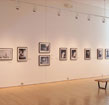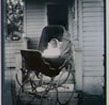
Exhibitions: Current | Upcoming | Past
Exhibitions: Past
Recovered Views
African American Portraits, 1912-1925
September 1 – October 5, 2006




This exhibition charts the recovery of an important story—that of an African American community in early twentieth-century Lincoln, Nebraska, and its photographer, now thought to be John Johnson. To the descendant families of many of the photo subjects, the portraits are family heirlooms and were never lost. But public attention on the photographer, his work, and the collective portrait they form of the Lincoln African American community has only begun to come into focus.
In 1999, the McWilliams family, whose roots in Lincoln date to the 1880s, showed their collection of glass plate negatives to John Carter of the Nebraska State Historical Society. Recognizing the significance of the work, he—along with researchers from the Lincoln/
Lancaster County Planning Department—have located additional photographs and investigated the identity of both the photographer and his subjects through archival research and oral history interviews.
Community members have shared family photos, memories, and introductions to relatives spread throughout the United States. Although the glass plates do not bear signatures or stamps, the accumulating evidence points to John Johnson as the probable photographer. Born in 1879, he was the son of Margaret and Harrison Johnson, a former slave and Civil War veteran. Johnson died in 1953, still living in the family home in Lincoln.
John Johnson has left an important legacy. His photographs depict African American life in the middle of the United States, a society rarely depicted in any medium. Of equal importance is the way Johnson portrayed his subjects—with respect and pride during a time of intense racial discrimination. His technical mastery of the photographic medium, understanding of pictorial composition, and rapport with the sitters gives the photos warmth and intimacy rarely achieved even by many well-known photographers of his day.
Photography at the Beginning of the Twentieth Century
Photographers like John Johnson working during this period were able to take advantage of rapid advancements in camera technology. Photography was becoming increasingly accessible and affordable, but it was still a highly challenging field. The cumbersome view camera required the photographer to compose and focus an upside-down image on a plate of translucent ground glass, and to do so while standing under a dark cloth.
Even under these challenging conditions, Johnson created images that evoke familiarity and ease. He clearly had a rapport with his sitters, many of whom he knew personally. Unlike many studio photographers of the period, Johnson maintained an air of informality in the portraits, giving his sitters the opportunity to express their personalities. Posing them on front lawns and porches or in front of painted backdrops, Johnson brilliantly manipulated space and proportion within the picture's frame. His handling of natural light and technical skill allowed him to use a full range of photographic tonalities. These are aesthetically sophisticated photographs full of grace, elegance, and respect for the subjects.
Between 1900 and 1940, increasing numbers of African American photographers established their own businesses, particularly in larger cities, producing traditional portraits as well as the popular postcard photo. Through their portraits, these photographers were able to challenge stereotypical images of African Americans that were often demoralizing and racist.
The forty prints in this exhibition were generated by Brixen Imaging of Lincoln, Nebraska, from digital files produced by the Nebraska State Historical Society's Gerald R. Ford Conservation Center digital imaging laboratory in Omaha. Five of these new prints were made from existing vintage prints, with the remaining thirty-five from original glass plate negatives. Rather than speculate about the photographer's intentions, the full plate has been printed, even when that means allowing elements of the location or set to show details that Johnson might have planned to crop from the final print.
Recovering the Stories
Looking at these warm, honest, sometimes humorous photographs, one would not know that John Johnson worked during the period of Jim Crow, a time of intense racial discrimination when segregation was legally upheld in both state and federal courts. Oral history interviews conducted with people in the photographs and with community members who can identify the subjects confirm that, regardless of education, most men worked as janitors, waiters, and porters, and the women as domestic servants. As in many cities throughout the country, Lincoln's African Americans lived in substandard housing and were often excluded from white-owned establishments.
This complicated life was described by participants in the oral history aspect of this project. Mrs. Ruth Talbert Greene Folley shared vintage prints and talked about the games she played as a child. John Reed described his foster mother's passion for helping the community. The Patrick sisters recognized many people and suggested their friend Pamona Banks James be interviewed, as she was known for being "sharp as a tack." Indeed, she recognized her great-uncle posing at his job, paving the streets of Lincoln.
These recovered views are shown here thanks to the generosity of community members who shared their images. Ruth Greene Folley, Tom Kaspar, and the McWilliams family loaned or donated original negatives and photographs. Many more people have contributed their time to help identify Lincoln's vibrant community of African American families, churches, clubs, businesses, and social groups, within a setting that was at once nurturing and discriminatory.
John Johnson's photographs seem to speak not about social oppression, but about the close ties of community, family, and home, of pride and strength even in humble settings. Despite the racism around them, the people in these photographs appear undaunted. Recovered Views is curated by John E. Carter, Special Projects Coordinator at the Nebraska State Historical Society in Lincoln. The exhibition is organized by the Nebraska State Historical Society and toured by ExhibitsUSA.
The purpose of ExhibitsUSA is to create access to an array of arts and humanities exhibitions, nurture the development and understanding of diverse art forms and cultures, and encourage the expanding depth and breadth of cultural life in local communities. ExhibitsUSA is a national division of Mid-America Arts Alliance, a private, nonprofit organization founded in 1972.
ExhibitsUSA is generously supported by the Adair Margo Gallery Inc.; Altria Group Inc.; James H. Clement, Jr.; ConocoPhillips; the Cooper Foundation; Douglas County Bank/Ross and Marianna Beach; DST Systems Inc.; Edward Jones; the William Randolph Hearst Foundation; the Helen Jones Foundation; the William T. Kemper Foundation, Commerce Bank, trustee; the Richard P. Kimmel and Laurine Kimmel Charitable Foundation Inc.; Land O' Lakes Inc.; Mrs. Tom Lea; the National Endowment for the Arts; the National Endowment for the Humanities; SBC Missouri; the Society of North American Goldsmiths; Sonic, America's Drive-In; Sterling Vineyards; the Summerlee Foundation; the Courtney S. Turner Charitable Trust; Valmont Industries; the Woods Charitable Fund; and the state arts agencies of Arkansas, Illinois, Kansas, Missouri, Nebraska, Oklahoma, and Texas.
ExhibitsUSA is a national program of Mid-America Arts Alliance.

